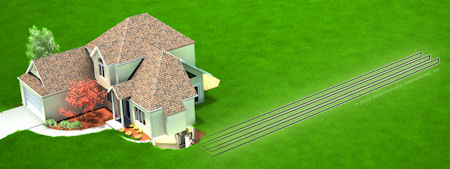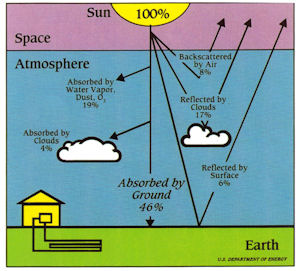
|
|
|
|
 |
||
Geothermal Heat Pump
|
|
If you own a small lot or have as little as 1 acre, it is possible that your geothermal system can use horizontal loops. It is important to note that is really doesn't matter which type of loop you use, vertical or horizontal, as long as the pipes are buried at least 5 feet underground. Trenches are dug with a backhoe or trencher. The trenches are anywhere from 6"-1' wide and around 6 feet deep. Polyethylene pipes (black plastic) are laid in the trenches and the trenches are backfilled with a sand-type material. A sand-type material is used so the pipes are in constant contact with a surface. Trenches are typically 100 feet (33m) to 300 feet (98m) depending on the ground source design. A typical residential geothermal system requires 1/4 acre to 3/4 acre for the trenches. The installation of horizontal loops is fairly simple and the trenches can be dug by a local contractor or a do-it-yourselfer. Prior to digging the trenches or deciding which type of loop is best for you consult with a reputable installer. |

Image used with permission from Waterfurnace, Int.
How A Geothermal Heat Pump Works
Wherever you live, the temperature beneath your home remains constant regardless
of the season. ClimateMaster® Geothermal Heat Pump Systems harness the stable underground temperature to provide
heating, cooling, and hot water at remarkably high efficiencies. So high, in fact, that energy use can be cut by up
to 80%. As the world’s largest and most progressive leader in clean, renewable geothermal technology, ClimateMaster
leads the way with its award-winning Tranquility Series geothermal heat pumps.
Click the image below to view an interactive demonstration of how geothermal heat pumps work to save you up to 80%
on your energy bills.

Phillip Rye - As Seen On Fox News


| Home Builder |
| Geothermal |
| Insulation |
| New Home Design |
| Ultimate Energy Action Guide |
XSitePro Templates
